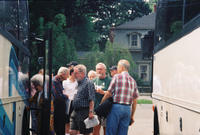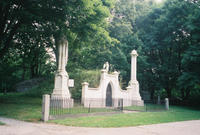Brockton, for readers who don't know, is not a classic holiday destination. It was once a bustling industrial city thanks to the shoe industry, it was the first city to electrified by Edison. But since the shoe industry moved south and then abroad, it has been all down hill for Brockton. It has some lovely old buildings but also, like so many cities, block upon block of derelict buildings, blocks of people living in substandard housing, hanging out on the street corners in this hot weather because there are few good jobs. When I was a very little girl, my grandparents lived there and I assume my grandmother grew up there before attending the nearby Normal School , now Bridgewater State College in Bridgewater, but I have no idea why they lived there or how long or what they did. Being there made me wonder about my grandmother and her family.
The Radisson is part of a huge shopping center on the north end of the town. We didn't see anything in Brockton
 , however. We got onto big white busses at 8 a.m. every day and we came back after 9 p.m. And we went from interesting old organ to interesting old organ. One day I stopped counting after organ number eight. At each church, an organist demonstrates the organ by playing various pieces which show you what it can do and by playing a hymn which all sing vigorously. Then OHS members swarm around the instrument commenting on its appearance, construction and sound, using the special language of organ geeks: spotted metal, chiff, . On the bus and at meals they swap stories of playing services under bizarre circumstances and talk about organs they have known (and yes, they make puns and double entendres galore about transplanting organs, whose organ is biggest, etc.) They speak of great 19th and 20th century organ builders like Erben, Hook and Hastings, E.M. Skinner, Johnson and Jardine with the tones of awed admiration which other people reserve for talking about celebrity sightings. The huge preponderance of OHS members are males who will not be fifty again and who also like vintage trains. Several OHS members are Early Music enthusiasts and at least one was sporting a "Clavichords for World Peace" T shirt.
, however. We got onto big white busses at 8 a.m. every day and we came back after 9 p.m. And we went from interesting old organ to interesting old organ. One day I stopped counting after organ number eight. At each church, an organist demonstrates the organ by playing various pieces which show you what it can do and by playing a hymn which all sing vigorously. Then OHS members swarm around the instrument commenting on its appearance, construction and sound, using the special language of organ geeks: spotted metal, chiff, . On the bus and at meals they swap stories of playing services under bizarre circumstances and talk about organs they have known (and yes, they make puns and double entendres galore about transplanting organs, whose organ is biggest, etc.) They speak of great 19th and 20th century organ builders like Erben, Hook and Hastings, E.M. Skinner, Johnson and Jardine with the tones of awed admiration which other people reserve for talking about celebrity sightings. The huge preponderance of OHS members are males who will not be fifty again and who also like vintage trains. Several OHS members are Early Music enthusiasts and at least one was sporting a "Clavichords for World Peace" T shirt.We had a great time but as a non organ geek, I found myself noticing other church things: how off putting it is that one bathroom had a plethora of signs about what not to flush and instructions for the preschool classes on handwashing; the cool folders the Episcopal Diocese of Massachusetts gives to parishes for their newcomer packets; the subltle ways in which churches communicate that they are lively communities or preservation societies. As our congregation struggles with making our 1938 building accessible to all people, I was feeling grateful that we at least have bathrooms on both levels of the church building, unlike some of these lovely older churches which have no bathrooms at all or whose gracious hosts direct you to the building next door down a flight of stairs. It was very very hot in MA and I faithfully drank water and in consequence could probably conduct the Church Ladies' Room Historical Society tour of Southern Massachusetts so I had plenty of opportunities for such reflections. .
We visited Christ Church, Swansea (Geo. S. Hutchings & Co. Opus 515), a lovely little church Henry Vaughan building like a little English church with an absolutely spectacular monument to the benefactors of the church in the lovely green cemetery. Also in Swansea was First Congregational Church, (E. & G.G. Hook Opus 460) which has a fascinating old fashioned chandelier.

Lunch was provided by Good Shepherd (RC) Parish in Fall River, speedy and courteous service. Someone claimed that now Indian casino gambling has caused bingo to cease to be a source of revenue for churches which instead are doing more and more catering for crowds. We visited First Congregational Church (Ernest M. Skinner Co., Opus 191) which has absolutely fascinating abstract Tiffany windows in the East end. You can see a picture of them here. We had dinner in a church that has ceased to be a church at all and is now the International Culinary Institute of Fall River, quite a spectacular Victorian Early English Gothic structure of red brick and stone (or concrete) almost as flamboyant as those English Victorian churches on which it is modeled, sometimes referred to as "blood and bandages". The organ survived but no attempt was made to play it. When it was Central Presbyterian Church, it was Lizzie Borden's church but this played no part in its decline, apparently. Or in her behavior, for that matter. Then on Thursday evening we went to St Anne's Roman Catholic Church which has statues in its clerestory arches, intended to make you feel surrounded by the Communion of Saints. They have a Cassavant. We had a concert of organ music and choral music. Luckily I am not a music critic.


No comments:
Post a Comment